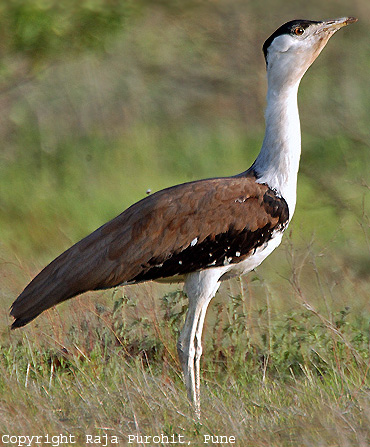Kingdom: Animalia Phylum: Chordata Class: Aves (Birds) Order: Gruiformes Family: Otididae |
|
Indian Bustard (Ardeotis nigriceps), alternate scientific name Choriotis nigriceps, is a scarce resident in India. It is found in the short grass plains and desert plains of west Rajasthan and Gujarat. This bird is on the endangered red list of IUCN due to its small and declining population. Indian bustard is the most endangered member of the bustard family in the world and the total population in wild may not exceed 700. Poaching and habitat deterioration are the two main causes for the drastic decline of the Great Indian bustard. The two sanctuaries where the Indian Bustard can still be seen are the Desert National Park (Rajasthan) and the Lala-Parjau sanctuary in western Kutch (Gujarat). Size: Male 120 cm Female 90 cm. Weight: 18 kg (Adult male). Identification: The Indian bustard is a tall, long legged bird. The underparts and neck are white, there is a black crown on the forehead and the upperbody is brown. The wings are marked with black, brown and grey. The sexes are similar in appearance although males have a larger black crown, long hind crown feathers and a black band across the breast. Nest: Nests are situated in the open ground and males take no part in incubation or care of the developing young; only a single egg is usually laid. The fledglings tend to remain with their mother until the following breeding season.
Food: Indian Bustards feed on beetles, grasshoppers, seeds and
groundnuts. |
| |

